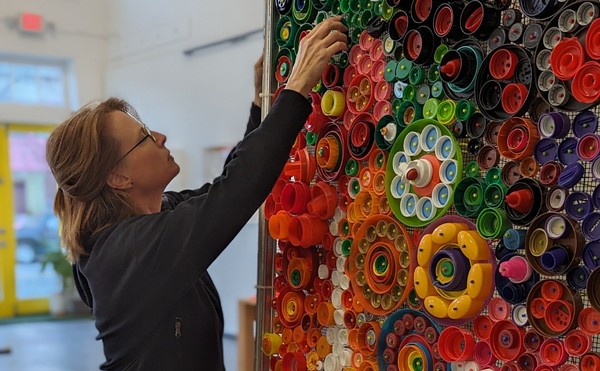Originally presented in 1853, La Traviata is based on Alexandre Dumas fils' 1852 weeper La Dame aux Camellias. (You may be more familiar with the MGM movie Camille, which one brilliant publicist immortalized with the blurb "Garbo Coughs.") The storyline manages to affront late-Victorian sensibilities even as it confirms them: For some, the wages of sin are debt; for others, death; and for the real wretches, both. Violetta's misfortune is to be a thoroughly emancipated woman who suffers both a pleural and a spiritual malaise: She has never truly loved. But when Alfredo Germont confesses at a party that he has adored her from afar, she resists but for a moment. She soon parts with jewels and property to support them both in a country hideaway, far from the Parisian bonne vie. But there is an ant at the picnic: Alfredo's father, who veers from brutal bullying to creepy near-maternal tenderness (Mom is not a factor) as he lengthily persuades Violetta to give up her true love for the sake of his family's honor. Violetta caves, and the lovers are reunited only for the famously tear-jerking death scene, in which vows of fealty are reaffirmed, even as the heroine literally breathes her last.
Like Verdi's earlier "hit," Rigoletto, La Traviata focuses on a single person. Because the female lead carries so much of the action alone, La Traviata unavoidably harks back to the bel canto tradition of Bellini's Norma (to say nothing of the star's much-telegraphed demise or the first act's near-"mad scene"). What was new, however, was the stark and uncomplicated plotline, the absolutely contemporary setting and its emphasis on emotion in place of drama, subplot or swordplay. Verdi also drew on his own tradition by including "Libiamo," an instantly familiar drinking song that rivals any of the master's patriotic choruses that so reliably topped the 19th-century Continental "pop charts."
A prodigious -- and restless-- composer, Verdi chewed through librettists with gusto, alternately meddling with, maddening and stringing them along on projects that he had long ago lost interest in. Verdi's partnership with Francesco Maria Piave was his longest-running and arguably his most successful -- apart from that with Arrigo Boito, his last librettist and the one unquestioned genius among his collaborators. OTSL showed its willingness to stick with a tremendously difficult libretto in Treemonisha, and the familiar La Traviata seems an odd and unfortunate place to overadjust in the opposite direction. The crispness of Joshua Major's direction and the exceptionally fine enunciation of all of the singers -- which should have been this performance's sterling virtue -- instead called all the more attention to words that would not pass muster on a average 1960s afternoon soap. In the OTSL production, Edmund Tracey translates Piave's trills and triplets of melodic Italian into easy-to-sing but excruciatingly banal English monosyllables. Sure, Italian is a relatively simple Romance language, but when there are four or five -- or even 15 -- English words to choose from for every dolore or amore, what possible excuse is there for limiting the entire opera to the vocabulary of an American 6-year-old?
Yet this is a captivating production, with a dazzling turn by Mary Dunleavy in the exhausting title role. Decades earlier, soprano Anna Moffo summed up the challenges of Violetta: One must be "a colaratura soprano for the first act, a lyric soprano for the second act, and a lirico-spinto, almost a dramatic soprano, for the last act -- all of this without losing the congruity of the vocal line." Dunleavy's range is gymnastic, her tone crystalline and her acting skills superb. She embodies the nobility of this character with grace and dignity but doesn't stint on giving Violetta an erotic edge, particularly in Act 2, when Alfredo's father, Giorgio (Gary Lehman, an authoritative if somewhat stiff baritone -- it's an impossible part), makes his outrageous proposal. And Dunleavy sings virtually the entire third act recumbent in a chaise wearing a corset -- hardly the most conducive conditions for tonal clarity. John Bellemer is Alfredo, Violetta's rather unsympathetic swain, and he's convincingly ardent (though, unlike the other males in the cast, he's not adorned with sweeping sideburns, a cosmetic choice that underscores his juvenile position). His voice is pleasant if not especially powerful, but his lightness of character is an effective foil for Lehman's genial darkness. Other supporting roles -- particularly Samuel Hepler as Dr. Grenville and Edyta Kulczak as Flora, Violetta's healthy-lunged counterpart in the high life -- were superbly presented, though Verdi has given them mere snippets to sing.
Conductor Stephen Lord has a brisk hand with his orchestra, and these familiar tunes (so many -- one forgets) sound fresh and new. Set designer Vincent Mountain has created a drawing room with large entrances through which one can see a backing wall. This is tiled with frames of various sizes holding gauzy mirrors. The reflected shadows in this ghostly gallery offer a compelling contrast to the sharply delineated performances (though Mountain's boxwood hedges in Act 2 are almost a little too real -- singers were tempted to sing a number of bars leaning against them upstage). Costumer Audrey Fisher has been firmly traditional in her wares -- the men are suited in long coats, the women in gloves and décolleté (though shouldn't the fortune-tellers be doing their palmistry on bare hands in Act 2?). Her palette is wisely limited, most strikingly in Flora's apartment, where the singers (gypsies and bons vivants) are garbed in white, black and red. Lighting designer Christopher Akerlind achieves memorable and chilling effects, especially when his tools are aimed at Violetta alone. As the opera begins, she is in a chemise on the floor, an overturned gilt chair by her side -- a posture we know we'll see again.
La Traviata continues through June 24.





